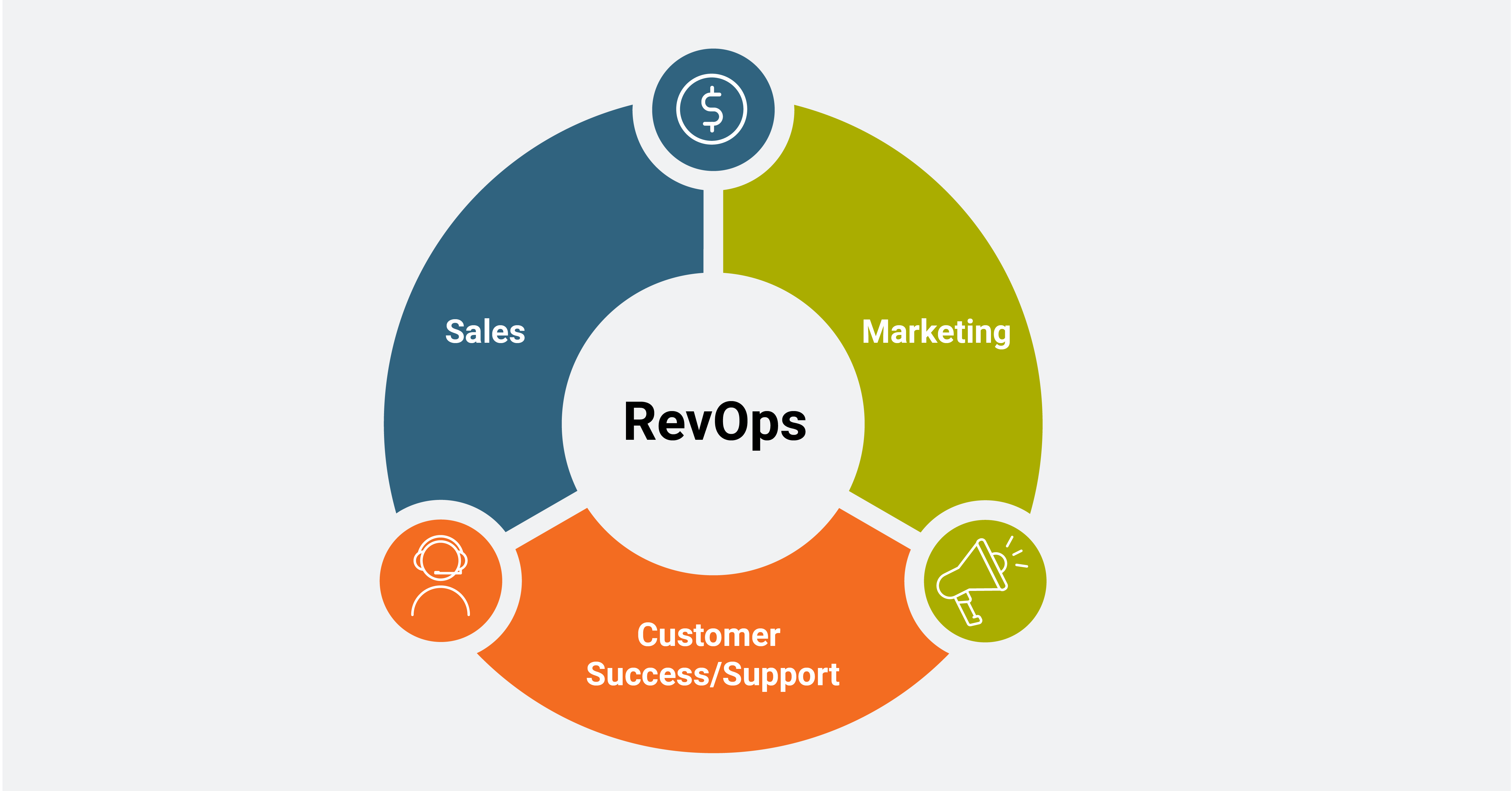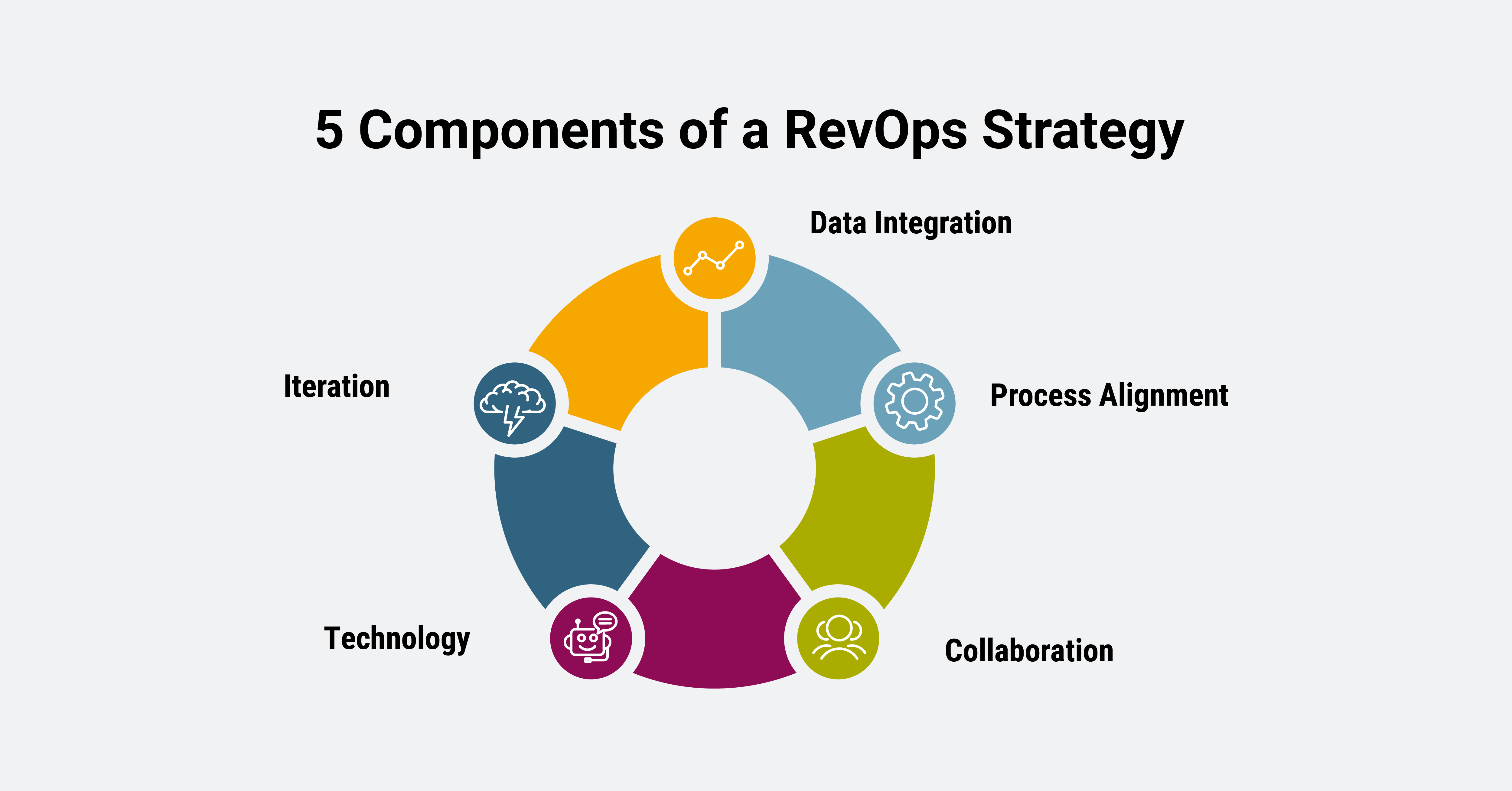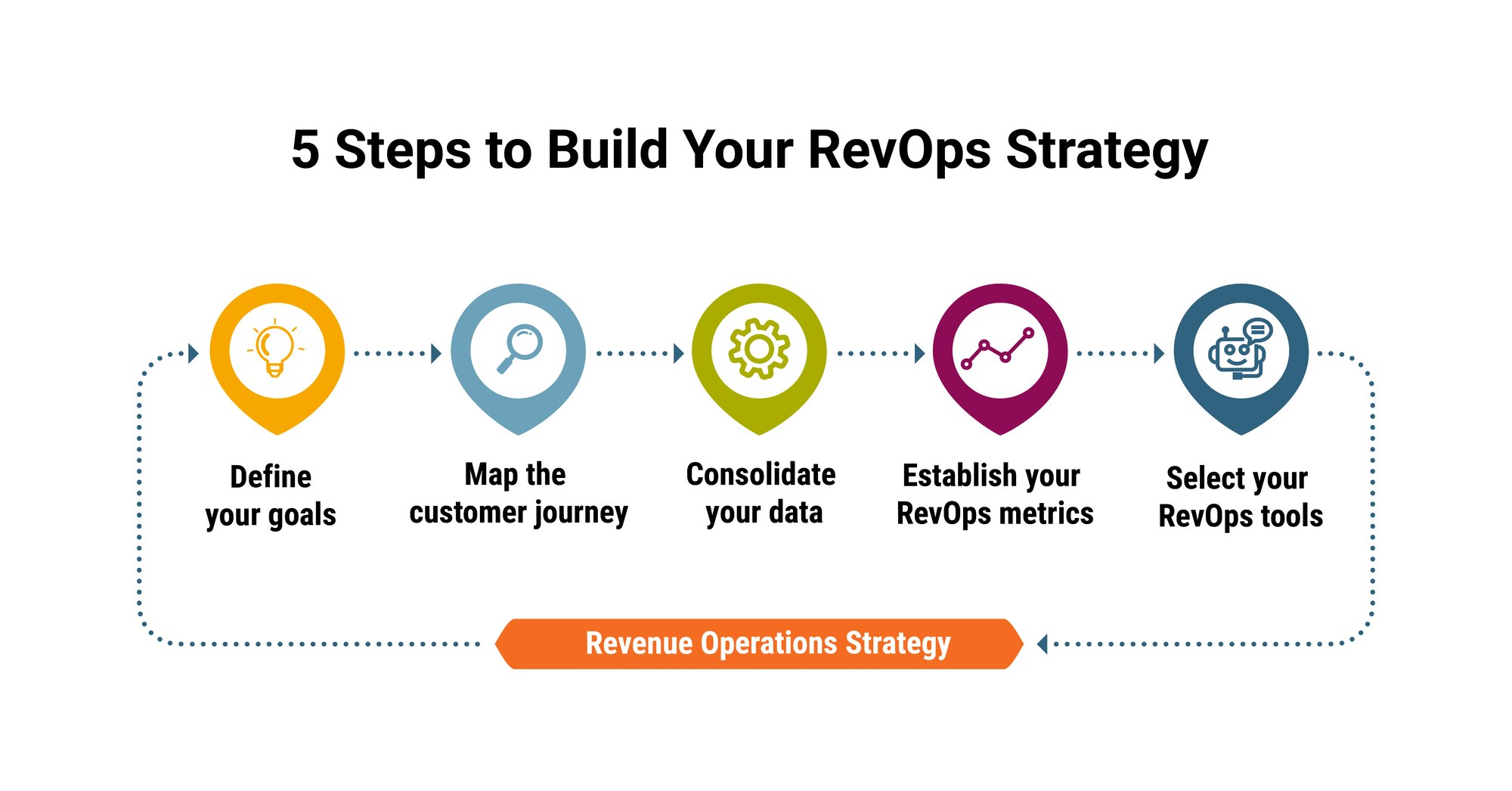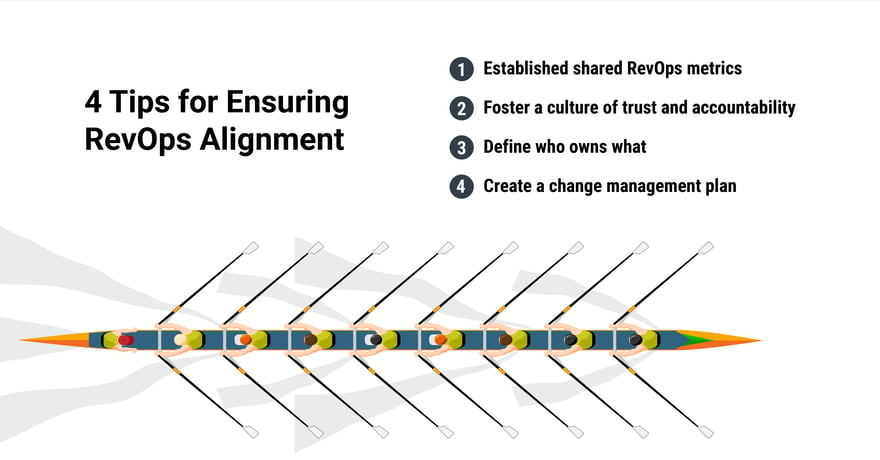Is your B2B RevOps strategy airtight? Read the guide to make sure it is.

Gaining a 360-degree view of the business has been a long-term goal for revenue growth leaders. Now that reality is within reach with the rise of Revenue Operations (RevOps). Organizations looking to drive sustainable and predictable revenue growth know that the formula for attaining that goal has changed.
Simply put: the old way of generating revenue doesn’t cut it anymore.
It’s not enough to convert a customer. You need to build a relationship with that customer long-term. And that requires end-to-end visibility across the entire customer journey and the commercial function working in tandem to increase the lifetime value of customers.
RevOps enables this shift. By aligning sales, marketing, and customer success/support functions, it provides growth leaders with a comprehensive and cohesive approach to drive operational efficiency and maximize revenue. But, like most new approaches, the journey to RevOps excellence isn’t easy.
Gartner predicts that by 2026, 60% of B2B organizations will fail to create a functioning end-to-end revenue process and revert to functional siloes. That’s because it takes more than just organizational design to be successful with RevOps.
The way to avoid this situation is with a winning B2B RevOps strategy.
A RevOps strategy is a cross-functional approach that seeks to maximize revenue growth within a business by removing the siloes between sales, marketing, and customer success. By unifying data, tools, and processes across the revenue cycle, go-to-market functions can collaborate to extract the most value across the customer lifecycle.

Ultimately, the goal is to boost operational efficiency, improve customer engagement, and empower organizations to drive sustainable and predictable revenue growth. Your RevOps strategy provides you with the roadmap for how to accomplish that. It addresses the roles and responsibilities needed to operationalize your RevOps function, the tools needed to achieve your objectives, and the metrics needed to measure success and performance.

Revenue data is a vital component of any RevOps strategy. Without it, understanding which growth levers to pull or which revenue streams to double down on is impossible. Integrating and consolidating data from all your revenue-generating sources, such as CRM systems, marketing automation platforms, and customer support tools, is key. It's what will provide you with a 360-degree view of the customer journey, enabling you to make data-driven decisions.
You need to align processes across the revenue cycle to ensure cross-departmental collaboration. Start by standardizing workflows, establishing SLAs across the go-to-market function, and optimizing the entire revenue operation process. Then take it further by documenting and sharing these operational improvements with the entire organization.
By now, it’s obvious that collaboration is the backbone of a successful B2B RevOps strategy. Driving revenue growth at scale would be difficult without it. RevOps enables the creation of a unified revenue function that works in sync to attract, convert, and retain customers effectively.
Collaboration may be the backbone of a winning B2B RevOps strategy, but technology is the thread that connects all functions and makes it happen. Integrated CRM platforms, marketing automation tools, sales enablement platforms, and more all play a crucial role in supporting and operationalizing revenue generation.
Continuous improvement is the name of the game for RevOps. The business environment is in constant flux, and understanding how to pivot and when to capitalize on emerging opportunities to gain a competitive advantage. Regularly evaluating your tools and processes is key. It’s what will give you the agility and resilience to operate amid evolving customer needs and market dynamics.
Developing a RevOps strategy can’t happen in a vacuum: leadership and key stakeholders across the commercial function need to be involved. Like assembling a high-performing sports team, you need to ensure you have all the right players in the right roles with a clear understanding of their goals and contributions to be successful with RevOps.
To that end, you need to ensure you’re involving sales, marketing, and customer success/support functions in the strategy development process. Each function plays a role. Think of sales as your frontline. They’re your boots on the ground with an ear and direct access to interacting with your customers. They understand what they want and why. The information sales provides is crucial in understanding how to best serve your customers before and after purchase.
Marketing, on the other hand, is the architect of the customer journey. Their knowledge of market trends, customer demographics, and competitive landscape can shape your overarching RevOps strategy. They can ensure your company has the proper positioning and messaging to effectively attract customers and keep them engaged long after the first transaction has been completed.
Finally, you need to have customer success/support. They’re the guardians of the customer experience. A customer’s experience with this team will ultimately determine if they stick or churn. Insights into common customer complaints, feedback, and retention strategies will ensure you successfully address leaks across the revenue cycle.
Collaboration and communication across these functions are paramount and can’t be stressed enough. Including them in the strategic planning phase will help you break down silos, drive alignment, and effectively implement your RevOps strategy.

Identify what you aim to achieve by implementing a RevOps strategy. It has to be specific and actionable for it to resonate with your team and to gain buy-in. For example, your goal could be to improve customer satisfaction. You could focus on creating better customer experiences or reducing response times to accomplish this goal.
Another example could be increasing predictability. Integrating and consolidating your tech stack to gain better visibility into the customer journey can help you achieve the insights you need to understand your most effective sales channels to drive predictable revenue growth.
RevOps is all about visibility. Knowing what sparks a customer to interact with your business and what they do after that initial engagement will provide the information you need to architect your RevOps strategy. More importantly, the exercise will help align your commercial functions by showing them how they can work better together to identify growth opportunities.
To map it out, start by pinpointing key touchpoints. Then, identify the system and tools needed and ensure that you clearly understand how they impact delivering an exceptional customer experience at each stage, then align stakeholders with them. Finally, analyze your customer journey map and highlight areas of improvement to enhance the customer journey.
Mapping out your customer journey is great. It helps you get a quick picture of your customer experience. But to get the whole picture, you need to dig into the data related to revenue, like product/service usage data and customer contracts. Seek to consolidate your data to create a single source of truth that will empower you and your commercial function to make informed business decisions proactively.
Explore data integration platforms, APIs, or middleware solutions to synchronize and consolidate data across platforms. The goal is to attain a seamless data flow between your CRM and other relevant systems so your team can operate as a single unit.
Make sure that the metrics you choose to measure the success of your RevOps strategy align with your goals. For example, if your goal is to increase revenue, select revenue-related metrics like sales growth or average contract value. Likewise, if the goal is to improve customer satisfaction, metrics like the net promoter score (NPS) or churn rate would be most useful.
You’ll also want to ensure that the metrics you select are actionable. The metrics you choose should provide insights into what is happening and how you can rectify it. Finally, you’ll want to be sure that all commercial functions are aligned on the metrics and understand their role in achieving the goal. This will ensure everyone works towards the same goal and reduce confusion or finger-pointing.
You don’t have to build your tech stack from the ground up. Rather, conduct an audit of your current toolset across departments and try to identify opportunities for consolidation or integration. By doing this you will reduce tool bloat and additional spending and confirm you are using them to their fullest potential.
Similarly, an audit will help you identify gaps in your tech stack, allowing you to further streamline the revenue-generating process. As you evaluate new tools to add to your tech stack, consider how each tool will simplify operations or automate repetitive tasks. You’ll also want to think about how the tool will support your overarching strategy and whether it will provide a more comprehensive view of the customer.
Getting people to rally around a common goal, adopt a new mindset, or a new way of operating isn’t easy. But it’s essential if you want your B2B RevOps strategy to be successful. To that end, here are a few tips to keep in mind to ensure alignment through the processes and how to gain buy-in and collaboration from the onset.

Work with key stakeholders to identify metrics to track. Each function should understand how each metric contributes to the overall objective and its role in making sure that it happens. Focusing on shared metrics ensures everyone works together effectively toward a common goal. It will enable each function to prioritize the tasks with the most significant impact and value.
Solving problems as a single unit can only happen if people are honest and hold each other accountable. That requires a culture built on trust. People need to feel comfortable being vulnerable to work together to support each other in achieving a common goal. Without it, it’s easy to revert to functional silos.
Avoid confusion and finger-pointing by clearly defining roles and responsibilities. This will enable each function to understand its role under the RevOps function and how it can best contribute to the overall strategy and goals. If you’re a team of one and you need more clarity on what to do next, check out this blog to learn what you can do to set up RevOps.
RevOps is a fundamental shift in your organization's operations. This can cause resistance among team members. A change management plan can alleviate the strain and ensure smooth adoption. This article does a great job going into the ins and outs of change management.
Implementing Your B2B RevOps Strategy
RevOps is fast becoming the go-to approach for driving revenue growth, attaining operational efficiency, and achieving alignment across all revenue-generating functions. But it's not a one-and-done deal. It’s an iterative process that requires continuous evaluation and optimization to be successful.
You need to commit to regularly reviewing data and optimizing the revenue-generating process. This will become second nature as you gain more customer data and cohesion in your team.
B2B growth marketing+pr agency Trevelino/Keller acquired Marsden Marketing in 2024, including its industry-leading MM Growth Marketing solution, powered by a data-forward approach rich in technologies including HubSpot, Salesforce and Pardot.
1042 Northside Drive NW
Suite 960
Atlanta, GA 30318
(404) 214-0722
info@marsdenmarketing.com